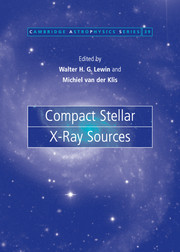Book contents
- Frontmatter
- Contents
- List of contributors
- Preface
- 1 Accreting neutron stars and black holes: a decade of discoveries
- 2 Rapid X-ray variability
- 3 New views of thermonuclear bursts
- 4 Black hole binaries
- 5 Optical, ultraviolet and infrared observations of X-ray binaries
- 6 Fast X-ray transients and X-ray flashes
- 7 Isolated neutron stars
- 8 Globular cluster X-ray sources
- 9 Jets from X-ray binaries
- 10 X-rays from cataclysmic variables
- 11 Super-soft sources
- 12 Compact steller X-ray sources in normal galaxies
- 13 Accretion in compact binaries
- 14 Soft gamma repeaters and anomalous X-ray pulsars: magnetar candidates
- 15 Cosmic gamma-ray bursts, their afterglows, and their host galaxies
- 16 Formation and evolution of compact stellar X-ray sources
- Author index
- Subject index
4 - Black hole binaries
Published online by Cambridge University Press: 01 September 2009
- Frontmatter
- Contents
- List of contributors
- Preface
- 1 Accreting neutron stars and black holes: a decade of discoveries
- 2 Rapid X-ray variability
- 3 New views of thermonuclear bursts
- 4 Black hole binaries
- 5 Optical, ultraviolet and infrared observations of X-ray binaries
- 6 Fast X-ray transients and X-ray flashes
- 7 Isolated neutron stars
- 8 Globular cluster X-ray sources
- 9 Jets from X-ray binaries
- 10 X-rays from cataclysmic variables
- 11 Super-soft sources
- 12 Compact steller X-ray sources in normal galaxies
- 13 Accretion in compact binaries
- 14 Soft gamma repeaters and anomalous X-ray pulsars: magnetar candidates
- 15 Cosmic gamma-ray bursts, their afterglows, and their host galaxies
- 16 Formation and evolution of compact stellar X-ray sources
- Author index
- Subject index
Summary
Introduction
Scope of this review
We focus on 18 black holes with measured masses that are located in X-ray binary systems. These black holes are the most visible representatives of an estimated ∼300 million stellar-mass black holes that are believed to exist in the Galaxy (van den Heuvel 1992; Brown & Bethe 1994; Timmes et al. 1996; Agol et al. 2002). Thus the mass of this particular form of dark matter, assuming ∼10 M⊙ per black hole, is ∼4% of the total baryonic mass (i.e., stars plus gas) of the Galaxy (Bahcall 1986; Bronfman et al. 1988). Collectively this vast population of black holes outweighs the galactic-center black hole, SgrA*, by a factor of ∼1000. These stellar-mass black holes are important to astronomy in numerous ways. For example, they are one endpoint of stellar evolution for massive stars, and the collapse of their progenitor stars enriches the Universe with heavy elements (Woosley et al. 2002). Also, the measured mass distribution for even the small sample of 18 black holes featured here is used to constrain models of black hole formation and binary evolution (Brown et al. 2000a; Fryer & Kalogera 2001; Nelemans & van den Heuvel 2001). Lastly, some black hole binaries appear to be linked to the hypernovae believed to power gamma-ray bursts (Israelian et al. 1999; Brown et al. 2000b; Orosz et al. 2001).
- Type
- Chapter
- Information
- Compact Stellar X-ray Sources , pp. 157 - 214Publisher: Cambridge University PressPrint publication year: 2006
- 460
- Cited by



